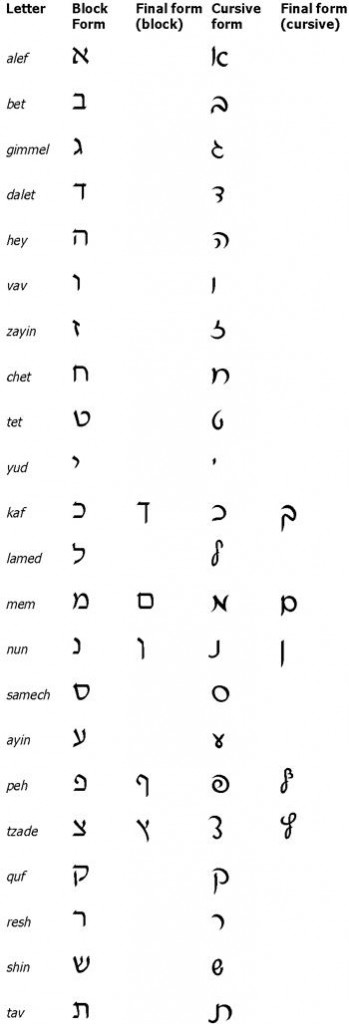Hebrew belongs to the Semitic family of languages which includes Arabic, the best know and most widely-spoken Semitic language. Like other Semitic languages, Hebrew is written from right to left (whereas English and other European languages are written left to right, the opposite direction).

The Hebrew word for ‘alphabet’ is alef-bet. The English word alphabet derives from alpha beta, the names of the first two letters in the Greek language. Similarly, the Hebrew word alef-bet derives from the names of the first two letters of the Hebrew alphabet, alef and bet. It is not just a coincidence that the two words, alphabet and alef-bet, are so similar as the ancient Greeks based their alphabet on the ancient Phoenician alphabet, a language closely related to ancient Hebrew.
The Hebrew alphabet consists entirely of consonants; there are no vowels. Native Hebrew-speakers have no difficulty with this since they have a good knowledge of the language and can easily work out how to pronounce the word from just the consonants, but ‘newbie’ Hebrew speakers can find this very challenging as they are uncertain what vowel sounds to insert into a word. Already in ancient times the rabbis worked out a series of additional markings (called diacritical marks in English) which can be added to indicate vowel sounds, but this is not normally done for native speakers of Hebrew. For more about vowel markings, see below.
The Hebrew language has two alphabets, the ‘block’ or ‘Assyrian’ alphabet used for printed books and articles, and the ‘cursive’ alphabet used when writing by hand (occasionally a book is printed in the cursive alphabet, but this is uncommon and done for effect).
Unlike English and European languages, Hebrew does not have capital letters. Thus the same form of a letter is used whether or not it is the first letter of a sentence or the first letter of a proper name. However, five Hebrew letters do have a ‘final’ form – a special form which is used if the letter is the final letter in a word.
A particular difficulty for English speakers in terms of pronunciation are the guttural letters khaf and chet, both of which make a guttural noise similar to the ch in the Scottish word loch even though they are often transliterated into English as ‘ch’.
[divider]
Vowels in Hebrew
Of course spoken Hebrew includes vowel sounds but these are usually not recorded in written Hebrew. However, there is a system of diacritical marks (called nikud in Hebrew) which can be added to written Hebrew to indicate the appropriate vowel sounds. Usually only non-native speakers of Hebrew bother with this as it requires considerable extra effort – in fact, many native speakers of Hebrew cannot read nikud as they have no experience dealing with it.
Nikud usually consists of dots placed above, below or next to the relevant consonants, but some vowel sounds are represented by short dashes or other marks under the consonants. The position and number of the dots is all-important in deciphering which vowel sound to make.
Hebrew written without nikud is called ‘unpointed Hebrew’ in English, and Hebrew written with nikud is called ‘pointed Hebrew’ in English.
[divider]
Dagesh
Confusion can be caused by dagesh, a dot which appears in the middle of some letters depending on various grammatical issues. Only some letters are capable of taking a dagesh, and the pronunciation of some letters is affected by the presence of a dagesh, but the pronunciation of some other letters is not affected by the presence of a dagesh. For example, the second letter of the Hebrew alphabet is bet, but it has two forms – one with a dagesh (called bet) and one without a dagesh (called vet). On the other hand, gimmel (the third letter of the alphabet) may or may not have a dagesh, but is pronounced the same in either case. Where the pronunciation of the letter is affected, the general effect of the dagesh is to harden the sound of the letter.
Dagesh does not indicate a vowel sound, but in spite of this it is considered part of the nikud. Thus dagesh will be found in pointed Hebrew texts but not in unpointed Hebrew texts.
